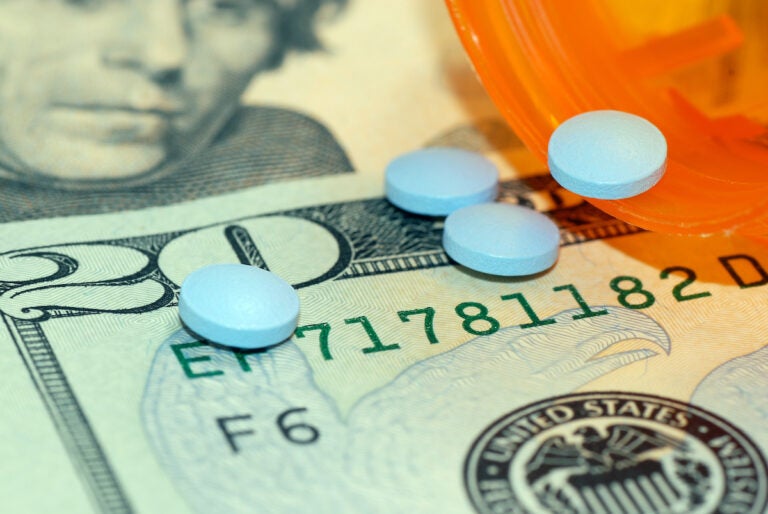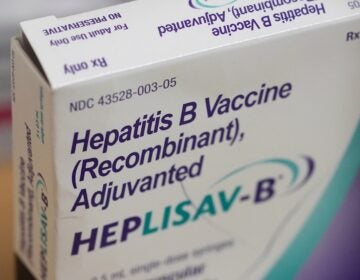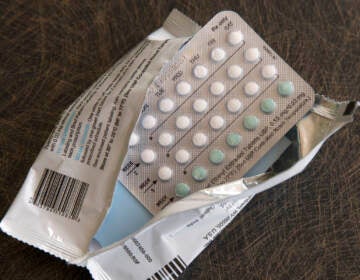Are financial incentives holding back cures?
A promising new cure sparked a wave of renewed interest in gene therapies about a decade ago — but it also set off alarm bells in the financial world.
Listen 11:55
Medication pills on top of US currency. (Bigstock/jpimages)
This story is from The Pulse, a weekly health and science podcast.
Find it on Apple Podcasts, Spotify, or wherever you get your podcasts.
When word of a revolutionary new hepatitis-C treatment first reached her clinic in Seattle, infectious disease specialist Nina Kim said it felt like a weight had been lifted off her and her colleagues.
“It was finally the breakthrough we were waiting for,” said Kim, who is also a professor at the University of Washington’s Department of Medicine.
This was over a decade ago, and hepatitis C, a blood-borne virus that can eventually cause liver cancer or failure, was killing more people in the U.S. than HIV.
Many of Kim’s patients were on the margins of society – Baby Boomers who received a blood transfusion before the Red Cross had started screening for the virus, and younger patients caught in the maelstrom of addiction.
The best treatments available then were not nearly as effective as what was coming down the pike, and they often came with terrible side effects.
Kim had trouble getting her patients to stick with it.
“We have to hold their hands through almost a year of treatment, and only then, in one and two [years], we have to tell them that the treatment didn’t work,” said Kim. “So I had a number of patients where I was telling them, ‘just hang on, we know this is coming. We have pure oral therapy coming down the road. That is supposed to be shorter, and it’s supposed to be much more successful.’”
The new treatments were Savoldi and Harvoni – made by the pharmaceutical giant Gilead Sciences.
The drugs took years, and likely hundreds of millions of dollars, to get to market. And they lived up to the hype.
“We were able to, with pretty well-tolerated treatment, cure over 95 percent of patients who completed treatment ended up with what we call a sustained virologic response, [where] we look for the virus and we don’t find it,” Kim said.
The breakthrough had come thanks in part to the explosion of knowledge in the field of genomic medicine, which had opened new avenues into treating previously untouchable diseases.
But the treatment came with a hefty and controversial price tag: more than $80,000 per course of therapy in 2014, or $1,000 a pill.
Despite the cost, the promising new cure for hepatitis C — along with a wave of renewed interest in gene therapies — set off alarm bells in the financial world.
Subscribe to The Pulse
In 2018, global investment banking firm Goldman Sachs released a report on the state of genome medicine, calling the introduction of Harvoni and Savoldi and one-time cures the “long awaited optimization of science” that held tremendous value for patients and society. At the same time, it cautioned that “such treatments offer a very different outlook with regard to recurring revenue versus chronic therapies” and could present a challenge for “sustained cash flow.”
Because, as the report indicates, more people cured of hepatitis C should mean less people passing it on to others. Soon, hepatitis C would be a thing of the past, and that could be a problem for Gilead and its revolutionary drugs.
In the news, this translated to multiple headlines that asked: “Is curing patients a sustainable business model?”
Randall Waechter, an associate director of research at St. George’s University and editor of “The Economics of Diseases and Cures” remembers the Goldman Sachs memo.
“I know it did create a little bit of a kerfuffle when it was released,” he said.
Waechter understands why so many people have pointed to this Goldman Sachs report as proof of their worst fears about Big Pharma — that corporations would rather sell patients a lifetime of treatments, rather than develop lasting cures — but he disagrees with their conclusions.
“I really perceive it to be an over-exaggeration or misreading of the report,” he said.
Genomic medicine was long thought to be the next evolution of medicine, but had been stalled for decades.
In 2017, just a year before the report was released, it was gaining steam again as the first gene therapy for cancer was approved. Technology like CRISPR had drastically cut the cost of working with the genetic building blocks behind life and illness.
The development seemed like a win-win for both patients and investors. Novel treatments for stubborn diseases should deliver better quality of life and higher returns.
But Goldman Sachs saw a hitch in this plan based on one case study: Harvoni and Savoldi.
“The memo does mention that existing therapeutic markets, like ongoing treatments for chronic disease, could be disrupted by these new one-shot cures as they call them,” said Waechter. “And they give the example of Gilead’s hepatitis-C vaccine.”
Technically the pills are curative treatments, not actually vaccines that prevent hepatitis C — but they definitely were revolutionary.
The company made about $10 billion in revenue from its hepatitis-C cures the year after they were released in 2014. But that number quickly peaked the year after.
So, would declining revenue still be enough to cover the cost it took to make the drugs possible in the first place?
Definitely, says Waechter. But pharmaceutical companies don’t just care about making their money back, they care about making a ton of money back for shareholders.
That means picking which diseases to cure that represent the most profitable investment.
“We live in a world of limited resources and so economic analysis is necessarily one of costs versus benefits, or return on investment,” said Waechter.
The cost of developing a new drug can vary from $300 million to $4.5 billion. These specific numbers are often regarded as trade secrets. According to Waechter, the top pharmaceutical companies likely spend anywhere from 14 to 30 percent of their revenue on research and development.
But this process is often built on more fundamental research done by publicly-funded health agencies like the National Institutes of Health. That means, Waechter said, that the ratio of taxpayer dollars to corporate cash spent on research lies somewhere between a 50/50 split, to one-third public, two-thirds private. A recent investigation found the federal government contributed over $60 million toward the development of Gilead’s hepatitis-C treatments. Exactly how this amount stacks up to the company’s private spending is unclear.
But one thing is certain: it’s most often Big Pharma that gets to choose where its dollars go in terms of investing in clinical trials. That means companies choose which diseases to focus on. And if a corporation is going to spend a billion dollars creating a cure, it is going to want to get the most bang for its and your buck.
The conclusion, according to that Goldman Sachs report, is that Big Pharma should target cures for diseases that aren’t infectious and have huge, replenishing patient pools — diseases like cancer. Those are the kinds of cures that companies should race to be the first to develop because they allow companies to maximize profit from what’s learned by publicly-funded research.
“If the big 10 pharma companies made $75 billion in profit in 2023, but it’s two and a half times more money they’re putting in to the R&D, then one could argue that $20 billion in annual corporate profits among the top 10 biggest companies are the result of public funding through institutions like the NIH,” said Waechter.
But it’s not just this profit-seeking selection method that stands in the way of new cures.
“It’s not true that companies are no longer interested in cures, but there are additional challenges,” said Jason Shafrin, a health economist and senior manager at FTI Consulting’s Center for Healthcare Economics and Policy in Los Angeles.
Shafrin said many of those challenges revolve around pricing.
If just one dose of a company’s new drug will cure a patient’s disease, that means insurance companies will have to pay a lot of money upfront to cover the cost of the cure’s development, rather than spreading out that payment over a patient’s lifetime.
“It may be a good deal, the kind of return on investment, for patients in terms of the health benefits relative to the cost may be very high,” said Shafrin. But financially and politically, he said, the steep price tag upfront seems hard to justify.
Shafrin said another obstacle is how to guarantee the long-term viability of cures. How are patients and insurers supposed to know whether experimental cures will really last?
Clinical trials can last up to five years. That is normally a sufficient amount of time to prove whether a treatment works or not.
But if that treatment eventually stops being effective, patients can always pause the medication and stop paying for it. One-time cures, on the other hand, are supposed to ward off disease forever. So they are priced that way.
“For cures, for things that you sell in gene therapies that you’re taking once, if you’re kind of paying for this, assuming it’s going to work for 10, 20, 30, 40, 50 years. And it ends up working six or seven. Well, then you way overpaid,” Shafrin said.
It can be difficult to get insurance companies to cover fairly standard treatments, let alone experimental cures.
“So, I think it’s not that [Big Pharma is] reluctant. It’s just that many of the cures are kind of one off things and some of them also are for orphan diseases. So, if you cure some disease that affects a small number of people that also can be challenging because obviously your market size is less,” said Shaffrin. “So I’d say [they are] certainly interested, but there are additional logistical and economic issues from a cure compared to a typical chronic disease treatment that you take for a bunch of time.”
Even with all these roadblocks, cures like Gilead’s hepatitis-C drugs still emerge.
Whether people can get their hands on them is another thing.
“Apart from patient level factors like social instability and competing priorities, our health system is … just not equipped to be very patient centered. There’s so many things wrong with it,” said infectious disease specialist Nina Kim.
Thus far, the future prophesied by that infamous Goldman Sachs memo – that Gilead’s hepatitis-C-curative treatments would lead to less people with the disease – has yet to come true.
Despite how well those treatments work, the opioid epidemic has caused the number of acute cases in the U.S. to double since their approval.
WHYY is your source for fact-based, in-depth journalism and information. As a nonprofit organization, we rely on financial support from readers like you. Please give today.







